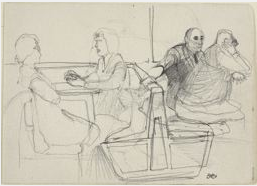As subjects for his work, he largely focuses on familiar city scenes, painting them with stunning photorealist detail. He photographs the subject and then works from the photograph to reproduce it with paint.
 |
| Study Drawing: New York Restaurant Source: The Art Institute of Chicago |
As scene in the image above, Estes begins his works with sketchy, study drawings, mapping out relationships between figures and objects in his subject scenes and determining areas of light and shadow.
After the study sketch comes a study painting, which adds color to the work but still leaves meticulous detail to later rendering of the work.
 |
| Study Painting: Figures in Cafeteria (oil on canvas) Source: Artnet, NY Marlborough Gallery |
His finished pieces demonstrate an unbelievable attention to and ability to create exquisite detail, as demonstrated in the following figure.
 |
| Painting: Lunch Specials (oil on canvas) Source: Artnet, NY Marlborough Gallery |
Estes' use and depiction of reflection in his work is especially amazing to me. Almost all of his subject scenes contain beautifully reproduced reflective elements (windows, cars, metallic surfaces), and I think that this feature in particular assists in elevating his work from being realistic to being photorealistic. Some of this can be scene on the eatery window in Lunch Specials above, but the following examples serve to highlight Estes' use of reflection in his work very well.
 |
| Painting: Citarella Source: Artnet, NY Marlborough Gallery |
 |
| Painting: Kentucky Fried Chicken Source: Artnet, NY Marlborough Gallery |
In Richard Estes' work, I admire the extreme amount of detail and realism that he is able to achieve. His work makes the viewer do a double-take and leaves them in disbelief that they are in fact looking at a painting rather than a photograph.
Sources:
Meisel, Louis K. Richard Estes: The Complete Paintings 1966-1985. New York: Harry N. Abrams, Inc., Publishers, 1986. Print.
Richard Estes. Artnet: The Art World Online, New York. Web. 2 Mar 2014. <http://www.artnet.com/awc/richard-estes.html>.
No comments:
Post a Comment